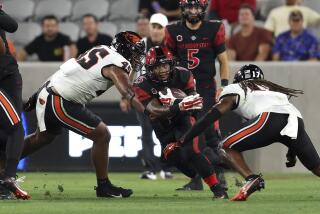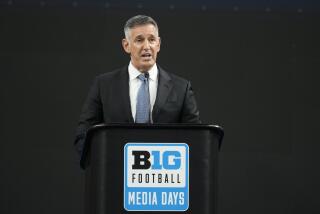Nevada Chosen to Replace Fresno State in Big West Conference
LOS ANGELES — The University of Nevada, which has one of the nation’s top Division I-AA football programs, will join the Big West Conference beginning in 1992-93, conference and school officials said Thursday.
The Wolf Pack, formerly known as Nevada Reno, will replace Fresno State, which announced in June that it will move to the Western Athletic Conference in 1992. Nevada, which has been competing in the Big Sky Conference, has eight men’s and seven women’s athletic teams that will be integrated into the Big West.
The addition of Nevada, which has an enrollment of 11,800, keeps the Big West at 10 member schools; all except UC Irvine and Santa Barbara will play Division I-A football.
“They were the only school we really considered,” Big West Commissioner Jim Haney said. “They are in the geographic footprint of the conference, and they’re a sister institution to Nevada Las Vegas. The quality of their football program makes them a viable Division I-A school.”
Nevada’s overall athletic program isn’t nearly as strong as Fresno State’s, but the Wolf Pack football team, which hasn’t had a losing season in the past 15 years under Coach Chris Ault, should be competitive in the Big West.
Since moving from Division II to Division I-AA in 1978, Nevada has advanced to the I-AA playoffs six times, reaching the semifinals each time and advancing to last season’s national championship game, where it lost to Georgia Southern, 36-13.
The Wolf Pack won Big Sky Conference championships in 1983, ’86 and ‘90, and Ault has a career record of 126-52-1 in 15 years.
Nevada has fared well against Big West opponents, handing Fresno State its only loss (40-26) of the 1982 season, defeating Nevada Las Vegas in 1990 (26-14), 1989 (45-7) and 1985 (48-7), and routing Cal State Fullerton in 1985 (30-3) and ’86 (49-3).
“I’m not saying they’ll slide in and be like Fresno State, but they’ll be competitive, definitely, like right away,” Fullerton Coach Gene Murphy said.
Nevada’s on-campus Mackay Stadium, which had a capacity of 14,000 in 1984, has been expanded to 20,000 and is being upgraded to hold 30,000 by the 1992 season. The Wolf Pack averaged 16,557 spectators for six regular-season home games last season.
The school also has an on-campus basketball arena, the 11,200-seat Lawlor Events Center, but the Wolf Pack’s basketball team has not been as successful as the football team. Nevada won Big Sky titles in 1984 and ’85 but has hovered around the .500 mark the past four seasons.
Big West baseball coaches are probably relieved to see Nevada replace perennial conference power Fresno State. The Wolf Pack baseball program, which was dropped from the West Coast Conference after last season and will compete as an independent in 1992, is 237-241-2 over the past eight years.
The Nevada golf team has been ranked among the nation’s top 30 for the past three years, and the school also offers men’s tennis, cross-country, and indoor and outdoor track.
“The opportunity to move to a Division I-A football conference, along with the opportunity to provide conference identity for three of our sports that are presently independent--baseball, men’s golf and women’s swimming--were all factors in our acceptance of the Big West’s invitation,” said Ault, who is also the school’s athletic director.
Dr. Joe Crowley, school president, said the move should help spur interest in Wolf Pack athletics among the school’s alumni.
“We have a history that looks to the West and thousands of alumni living in Southern California and Southern Nevada,” Crowley said. “It’s a good move for the university.”
Nevada’s seven women’s sports are volleyball, basketball, tennis, swimming, cross-country, and indoor and outdoor track. Swimming has been Nevada’s most successful women’s sport, but the Wolf Pack hasn’t fared well in basketball (5-22 last season) and volleyball (2-26 last season).
“Nevada should be competitive in some programs, but they may have their biggest trouble in volleyball and women’s basketball,” Haney said. “But I think the potential to grow is there for all sports, because they’ll be playing in areas where they’ll want to recruit.”
More to Read
Go beyond the scoreboard
Get the latest on L.A.'s teams in the daily Sports Report newsletter.
You may occasionally receive promotional content from the Los Angeles Times.











